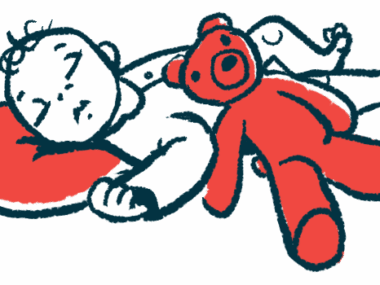Spinraza Clinical Trial Updates Confirm Treatment Benefits in All SMA Types
Written by |

A Phase 3 clinical trial evaluating Spinraza (nusinersen) in children with type 2 spinal muscular atrophy (SMA) may play a decisive role in whether private insurers cover the treatment in later-onset SMA patients — those with type 2 and type 3.
The study was the focus of an Emerging Science Session presentation Tuesday at the annual American Academy of Neurology meeting in Boston. Dr. Richard Finkel, a trial investigator and chief of neurology at Nemours Children’s Hospital in Orlando, Florida, delivered the presentation.
The high cost of Spinraza has been an issue in whether insurers should cover the drug.
CHERISH (NCT02292537) investigated the effectiveness of Spinraza, versus a placebo, in 126 children between the ages of 2 and 12 who were diagnosed with SMA after they were 6 months old. All were able to sit, but not walk, independently. Each was treated with four 12-mg doses of Spinraza or a placebo over 15 months.
Data from an interim analysis, released in November, showed a significant improvement in motor skills and muscle function, as measured by a greater than three-point improvement in the Hammersmith Functional Motor Scale-Expanded (HFMSE) after 15 months. Mean improvement in the CHERISH trial was four points in treated children, compared with a 1.9-point decrease in the non-treated group.
That data, together with promising interim results from another Phase 3 trial in infants with type 1 SMA, led to Spinraza becoming the first SMA therapy to receive U.S. Food and Drug Administration approval to treat SMA types 1–4 in children and adults, in December 2016. The other trial was the ENDEAR study (NCT02193074).
The $125,000-per-vial price that Biogan put on Spinraza was met with criticism and concern, however. That price means the first year of treatment will likely cost $625,000 to $750,000 for five or six injections. And subsequent years of three injections annually will be about $375,000.
Two insurance companies, Humana and Anthem, announced they will cover Spinraza only in patients with SMA type 1, and only if they respond to treatment. United Healthcare has said it will cover patients with SMA type 1, 2 and 3, but with limitations on its initial and continued use.
Biogen, which is licensing Spinraza from Ionis Pharmaceuticals, has set up a program to help families with health insurance approvals and financial support.
Both CHERISH and ENDEAR were stopped early after Spinraza proved effective. The enrolled children were moved to an ongoing open-label extension study, SHINE (NCT02594124), where all patients are receiving the treatment.
In additional presentations at the Boston meeting, Biogen researchers showcased data from the ENDEAR and NURTURE trials.
A Monday morning presentation of data from ENDEAR showed that participants continued improving, compared with a previous interim analysis. Fifty-one percent of treated children met motor developmental milestones, compared with none of those receiving the sham procedure, the results indicated.
Spinraza also nearly halved the risk of a patient having to go on ventilation, or a patient dying, and it increased patients’ overall survival. A majority, 71 percent, improved their scores on the CHOP INTEND assessment of neuromuscular function, compared with 3 percent in the control group.
The NURTURE Phase 2 study (NCT02386553) looked at Spinraza in infants with a genetically confirmed SMA diagnosis who had yet to develop symptoms. The children were followed from just after birth to 2 1/2 years of age.
The trial’s main outcome measure, to be presented on Thursday afternoon, was the time to death or a patient having to go on mechanical ventilation.
This ongoing study has enrolled 20 participants, of which 13 had two copies of the SMN2 gene. Such a low gene copy number is usually seen in patients with SMA type 1.
As of Oct. 31, 2016, all children in the study were alive without the need for ventilation. This meant that the study met its primary endpoint, as did the earlier trials of the treatment.
Researchers also examined motor developmental milestones using the Hammersmith Infant Neurological Examination (HINE) scale. It showed improvements in 89 percent of treated infants, who also had weight gain similar to that in normally developing children. Muscle electrical properties also improved in most children.
Biogen explained the design of the CHERISH study in a poster session showcased on Tuesday.






